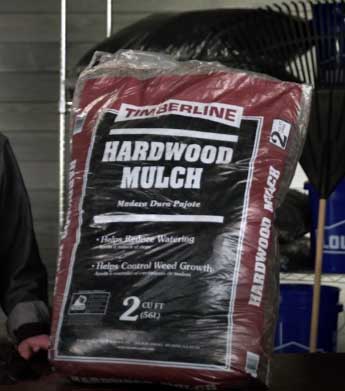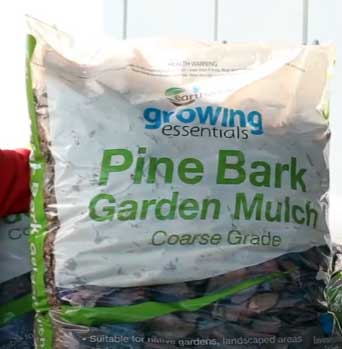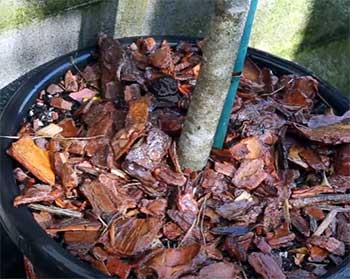I’ve spent countless weekends transforming my backyard into a thriving garden, and one question keeps popping up: which mulch is the real MVP—hardwood or pine bark? Both are popular, but they bring different vibes to the table.
In this article, I’ll break down their features, weigh their pros and cons, and help you decide what’s best for your garden. Whether you’re a seasoned green thumb or just starting out, let’s explore these mulches together and find the perfect fit for your soil.
A Brief Comparison Table
| Feature | Hardwood Mulch | Pine Bark Mulch |
| Source | Deciduous trees (oak, maple, etc.) | Pine tree bark |
| Cost | Affordable, often cheaper | Slightly pricier, varies by region |
| Appearance | Fine texture, uniform look | Chunky, rustic aesthetic |
| Decomposition Rate | Breaks down faster (6-12 months) | Slower breakdown (1-2 years) |
| Nutrient Contribution | Adds organic matter, improves soil | Minimal nutrient release |
| Weed Suppression | Good, but less effective over time | Excellent, dense coverage |
| Water Retention | Moderate, needs topping up | Excellent, holds moisture longer |
| pH Impact | Neutral to slightly alkaline | Slightly acidic, good for acid-loving plants |
| Durability | Less durable, needs frequent replacement | Long-lasting, retains structure |
| Availability | Widely available, often recycled | Common, but availability varies |
My First Encounter With Mulch
When I first started gardening, I thought mulch was just a fancy way to cover dirt. Boy, was I wrong. Mulch is like the unsung hero of any garden—it keeps your plants cozy, your soil moist, and those pesky weeds at bay.
But not all mulches are created equal. Hardwood and pine bark mulch, two of the most popular options, have been battling it out in my garden beds for years. Each has its strengths, quirks, and trade-offs, and I’ve learned a thing or two about them through trial, error, and a lot of dirt under my fingernails.
Let’s break it down. Hardwood mulch comes from deciduous trees like oak, maple, or ash, often sourced from recycled wood or tree trimmings. It’s finely shredded, giving it a polished, uniform look.
Pine bark mulch, on the other hand, is made from the bark of pine trees, typically in chunkier nuggets or shredded strips. It’s got a rugged, natural vibe that screams “forest floor.” Both are fantastic, but they cater to different needs, aesthetics, and budgets.
Let’s explore what makes each one shine—and where they fall short.
Why I Love Hardwood Mulch?

Hardwood mulch is my go-to when I want a budget-friendly option that gets the job done.
It’s often made from recycled wood, like old pallets or tree trimmings, which makes it widely available and easy on the wallet.
In my area, a cubic yard of hardwood mulch costs about 20-30% less than pine bark.
That’s a big win if you’re covering a large garden or working with a tight budget.
Another thing I appreciate is how hardwood mulch breaks down. It decomposes relatively quickly—usually within 6 to 12 months—adding organic matter to the soil. This is a game-changer for my vegetable garden, where nutrient-rich soil is key.
As it breaks down, it feeds the soil, encouraging earthworms and microbes to do their magic. My tomatoes and zucchini seem to love the extra boost.
Hardwood mulch also spreads like a dream. Its fine texture makes it easy to rake into an even layer, giving my garden beds a clean, professional look. Whether I’m mulching around delicate flowers or sturdy shrubs, it settles nicely and doesn’t clump or blow away in the wind.
Where Hardwood Mulch Falls Short?
But it’s not all sunshine and roses. The fast decomposition that I love can also be a headache. Because it breaks down quickly, I find myself topping up my beds at least once a year, sometimes more in heavy rain areas.
This can get old fast, especially if you’ve got a sprawling landscape.
Weed suppression is another area where hardwood mulch doesn’t always shine. It does a decent job at first, but as it breaks down, gaps form, and weeds start sneaking through. I’ve had to pull more dandelions than I’d like to admit from my hardwood-mulched beds.
Plus, if the mulch isn’t sourced properly, it can sometimes contain bits of treated wood or debris, which isn’t great for organic gardening. I’ve learned to double-check with suppliers to ensure I’m getting clean, natural hardwood mulch.
Another quirk? Hardwood mulch can sometimes compact over time, especially after heavy rain. This can reduce its ability to retain water, which means I’m watering my plants more often than I’d like. It’s not a dealbreaker, but it’s something to keep in mind if you’re in a dry climate.
Why Pine Bark Mulch Steals the Show?

Now, let’s talk about pine bark mulch. The first time I used it, I was hooked on its rustic charm.
Those chunky nuggets or shredded strips give my garden a natural, woodland feel that hardwood mulch can’t quite match.
It’s like my flower beds are channeling a forest getaway, and I’m all about it.
One of the biggest reasons I reach for pine bark is its durability.
Unlike hardwood mulch, pine bark takes its sweet time breaking down—often lasting one to two years.
This means less frequent trips to the garden center and fewer weekends spent mulching. For someone like me with a busy schedule, that’s a huge plus.
Pine bark mulch is also a rockstar at weed suppression. Its dense, chunky texture creates a tough barrier that weeds struggle to penetrate. I’ve noticed far fewer intruders in my pine bark beds compared to my hardwood ones.
Plus, it’s fantastic at retaining moisture. My azaleas and hydrangeas, which love a moist environment, thrive under pine bark’s protective layer. It’s like giving your plants a cozy blanket that holds in water.
Another perk? Pine bark is slightly acidic, which makes it a dream for acid-loving plants like blueberries, rhododendrons, or camellias. I’ve seen my azaleas bloom brighter since switching to pine bark in those beds.
If your garden is full of these plants, pine bark might just be your new best friend.
The Downsides of Pine Bark Mulch
But pine bark isn’t perfect. For one, it’s usually pricier than hardwood mulch. Depending on where you live, it can cost 20-50% more per cubic yard.
That can add up if you’re mulching a large area. I’ve had to budget carefully when using pine bark for bigger projects.
Another thing I’ve noticed is that pine bark doesn’t contribute much to soil fertility. Unlike hardwood mulch, which breaks down and enriches the soil, pine bark is stingy with nutrients.
If you’re relying on mulch to feed your soil, you might need to supplement with compost or fertilizer when using pine bark.
Spreading pine bark can also be a bit of a chore. Those chunky nuggets don’t always play nice with a rake, and getting an even layer takes some effort. I’ve spent more time than I’d like wrestling with pine bark to make my beds look tidy.
And while it’s great for moisture retention, it can sometimes hold too much water in poorly drained areas, leading to soggy soil or even root rot in sensitive plants.
Breaking Down The Key Features of Hardwood Mulch And Pine Bark Mulch
Let’s get into the nitty-gritty of what sets these mulches apart. Both hardwood and pine bark mulch serve the core functions of mulch: weed control, moisture retention, temperature regulation, and aesthetics.
But their differences come down to a few key features.
- Cost and Availability

In my experience, hardwood mulch is usually the more budget-friendly option.
It’s often made from recycled wood, which keeps costs down and makes it easy to find at local garden centers or even through municipal programs.
Pine bark mulch, while widely available, tends to be pricier due to its specific sourcing from pine trees.
If you live in an area with lots of pine forests, you might score a better deal, but in my neck of the woods, it’s consistently more expensive.
- Aesthetics
This one’s a matter of taste. Hardwood mulch’s fine texture gives my garden a sleek, polished look, like a freshly made bed. It’s perfect for formal gardens or modern landscapes. Pine bark, with its chunky, rugged nuggets, feels more like a hike through the woods.
I love using it in naturalistic settings or around evergreens. You’ll need to decide which vibe suits your garden’s personality.
- Decomposition and Soil Health
Hardwood mulch is like a generous friend who shares their snacks—it breaks down quickly and enriches the soil with organic matter. This is great for vegetable gardens or beds where soil health is a priority.
Pine bark, on the other hand, is more like that friend who keeps their snacks to themselves. It lasts longer but doesn’t give much back to the soil. If you’re focused on long-term soil fertility, hardwood might have the edge.
- Weed and Moisture Control
Pine bark takes the crown for weed suppression. Its dense structure makes it tough for weeds to break through, saving me hours of weeding. It also excels at holding moisture, which is a lifesaver in hot, dry summers.
Hardwood mulch does a decent job in both areas, but it’s not quite as effective, especially as it breaks down over time.
- pH and Plant Compatibility
If you’ve got acid-loving plants, pine bark is your match. Its slightly acidic nature creates the perfect environment for azaleas, blueberries, and other pH-sensitive plants.
Hardwood mulch is more neutral, sometimes leaning slightly alkaline, which makes it versatile for a wide range of plants but less ideal for acid lovers.
My Experience With Hardwood And Pine Bark Mulch

Last spring, I decided to put both mulches to the test in my backyard.
I used hardwood mulch in my vegetable garden and pine bark around my ornamental shrubs.
The results were eye-opening.
The hardwood mulch worked wonders for my tomatoes, breaking down over the season and giving the soil a rich, crumbly texture.
But by fall, I was already adding a fresh layer to keep weeds at bay.
The pine bark, meanwhile, was a low-maintenance dream around my shrubs. It looked fantastic, held up through heavy rains, and kept weeds to a minimum.
But when I checked the soil underneath, it hadn’t changed much—no surprise, given pine bark’s slow decomposition. I also noticed my hydrangeas were thriving, likely thanks to the slightly acidic conditions.
One thing I didn’t expect? The pine bark nuggets were a pain to spread around my irregularly shaped beds. I ended up with some uneven patches that took extra effort to fix. The hardwood mulch, being finer, was much easier to work with in tight spaces.
Making The Choice: What’s Right For You?
Choosing between hardwood and pine bark mulch comes down to your garden’s needs, your budget, and your aesthetic preferences. If you’re like me and love a tidy, nutrient-rich garden on a budget, hardwood mulch is a solid pick.
It’s affordable, versatile, and great for soil health, even if it means more frequent top-ups.
If you want a low-maintenance, long-lasting option with killer weed control and a rustic look, pine bark is the way to go. It’s pricier and doesn’t feed the soil much, but it’s a champ at keeping your beds looking sharp with minimal effort.
Plus, if you’ve got acid-loving plants, it’s practically a must-have.
Think about your climate, too. In my humid, rainy area, pine bark’s moisture retention is a blessing, but in a drier climate, hardwood’s faster breakdown might be less of a hassle.
Also, consider how much time you can dedicate to maintenance. If you’re a weekend warrior like me, pine bark’s durability might save you some sweat.
Frequently Asked Questions (FAQ)
It depends on your needs. Hardwood mulch is better for soil enrichment and affordability, while pine bark excels in durability, weed control, and supporting acid-loving plants.
Pine bark mulch is pricier, harder to spread evenly, and doesn’t contribute much to soil fertility due to its slow decomposition.
Hardwood mulch breaks down quickly, requiring frequent replacement, and is less effective at weed suppression as it decomposes. It may also compact, reducing water retention.
Pine bark mulch is often considered the best bark mulch for its durability, weed control, and suitability for acid-loving plants, but it depends on your garden’s needs.
Wrapping It Up
So, there you have it—my journey through the world of hardwood and pine bark mulch. Both have their strengths, and both have earned a place in my garden at different times.
Hardwood mulch is my budget-friendly, soil-loving friend, while pine bark is the low-maintenance, stylish choice that keeps my beds looking sharp. Your garden is unique, so think about your plants, your budget, and the look you’re going for.
Whether you choose hardwood’s nutrient boost or pine bark’s rugged charm, you’re setting your garden up for success. Happy mulching!
